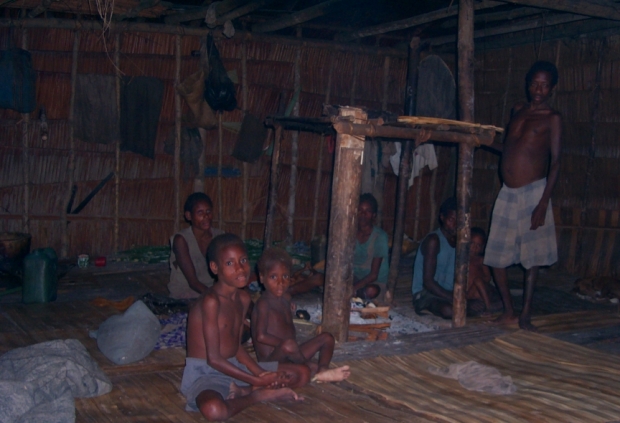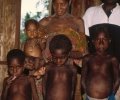Greenhorn Doctor
That unforgettable, and nightmarish, case was started with a SOS radio message from Pirimapun. I had just arrived in Bayun a week before. Pater Bob, the caller, could not describe the condition of the patient beyond “she has a problem in delivering her baby.”
I asked Ambo, the motorist, to prepare the slup; myself the medical supply—which was available very little and incomplete. Sister Dorothea, the nurse assistant, came along because I needed someone who had medical experience in Asmat.
The tide was still low; some people ‘help’ us push the slup on the mud for about 600 meters before reaching the water. Walking in the mud was heavy; the farther from the shore, the deeper our legs stuck in the mud; we walked like a toddler walking: pulling out the back leg slowly of the sticky black mud, moving it forward above the surface, and sticking it back into the mud in front of the other leg. The boat was heavy because Sister Dorothea—about 90 kilogram—was sitting in it; she had an excuse I could not argue: impossible walking in the mud with her Sister’s robe on. By the time we reached the water line, the mud surface was at our upper thigh.
I sat on the wall of the boat, removed the mud off my legs, and paid the pushers to make sure they would ‘help’ us again next time. Ambo followed me and lowered the engine tail. Got set.
The boat cruised slowly because the sea was still rough. Normally, it only took 45 minutes to go to Pirimapun. After one hour, we just passed Kajerin village, the only village between Bayun and Pirimapun. The waves hurled our slup up like a dolphin tossing a ball up with its beak in the show. Wet and hurt on the butts and face. The thought of ‘could I reach the shore if the boat turns upside down?’ stayed in my mind all the way.
“River Cook,” Ambo pointed the shore. The river was named after the famous captain James Cook. He landed here in 1770 and lost more than ten of his men during a picnic along the beach around here. His party was attacked by native savages carrying barbed spears and bamboo tubes from which lime was thrown.
Pirimapun lies on the right bank of the river mouth. We passed the remnant of a complex of buildings about 500 meters before landing on the shore. It used to be a Protestant Mission Hospital. In 1970s, Ken Dresser, a Canadian doctor, relocated it to Senggo because Pirimapun was too harsh; abrasion rate was fast
On the shore, the local people took me to the first house from the coast. “Hooi. Welcome to the cage of mud,” a white man greeted me. He was about 60, I guessed. Skinny and dirty. “Bob Badhuin.” He introduced his name.
Bob was an American Maryknoll Father. He was about my height, 170 cm, and bald. He had lived in Asmat for ten years. “What do you like to drink?” he asked.
“What do you have, Pater?” I did not want to drink the water because it was not boiled, I had known about it. I chose orange juice in the bottle. He lighted a cigarette; he was a chain smoker–a year later he had a lip operationto remove a cancer. I did not take his meal offer; I wanted to see the patient right away. Anyway, he only offered me a piece of tasteless and rubber-like sago, his daily menu—no nun lived in Pirimapun, nobody cooked for him. His doctor in the USA diagnosed him malnourished one year later.
“Pater, could you tell me about this patient?”
“People said this woman had been sick since last night. She had wanted to deliver her baby, but she could not.” That was it. Bob had never been interested in medicine, the opposite of Ton.
People took me to the village. We followed a soil path for about 300 meters before turning to the left. Two rows of long houses lined the slippery clay path. We stopped in front of a house where many people were gathering. It was so noisy; they were talking, crying and screaming. I jumped over the drain; looked into the house through the door—the floor about my neck—but saw nothing clearly, too dark.
“Where is the ladder?’ I asked.
“Here, Doctor.” It was a serrated log at the corner leaning against the patio floor. I crawled the ‘ladder’—why did not they make a better one? Wood was abundant around—it was moving. The porch floor was a frame of sticks bound by plant stems; I passed it carefully—I did not want to end up under the house, 1.5 meter down below.
The people were silent when I stepped in. I heard ‘doctor’ word repeated around. After a minute, my eyes were adjusted to the darkness. So many of them. Eight fireplaces meant eight families, but it seemed the number of people inside more than 8 families. They floor was very messy. My eyes hurt from the fire smoke. They led me to the big crowd at the third fireplace on the left. I could not see the patient.
“Could you ask them to move away?” I asked my guide, the teacher, and he did so.
The patient was lying still by the fireplace. It is hard to tell her age in the darkness. A piece of dirty cloth cover her waist and below; upper part naked. The woman’s eyes were closed. I lifted the cloth and saw two things between her legs. They were lying on the bloody floor. My heartbeat raced. I pointed my flashlight to them. One was obviously a baby and still alive. What was the other one?
I returned to the patient, evaluating her consciousness. She did not respond to my call, but did to the pain stimulation. Pre-coma. She breathed heavily; upper respiratory tract was clear; pulse weak but palpable. I focused back to the baby, a boy. His umbilical cord was still attached to his umbilicus. I followed the cord. I was shock. The cord terminated in the other ‘thing’. It was the uterus, the womb. How on earth it ended up on the floor of the house?
I clamped the cord in two spots; tied it with a thread about 10 cm from the baby’s navel; and the cut between the forceps. Having make sure the baby had no breathing problem, I handed him to a woman. Now I was ready to deal with the strayed womb.
The end of the cord was embedded in the outer wall. The placenta was still intact–partially off the wall–but it was supposed to be attached in the inner wall of the womb. It meant . . . the womb had been inverse! Invertio uteri. I had only seen its picture in one obstetric textbook. There was no text how to manage it. Reversed it first and then pushed in, or the other way around? I did not have much time to think because of the patient’s critical condition.
I had to secure an intravenous line because the mother was in shock from profuse bleeding and dehydration. I palpated her right arm but could not feel the vein; it was too dark—both skin and room—to see it. I switched to the other arm but no luck. I punctured IV catheter blindly a couple times into the anatomical area of the veins, but no blood flowed into it when its needle was pulled up. The patient were grunting and writhing around harder.
I moved back to the uterus and had a better look. The placenta was partially off the wall; I asked Sister Dorothea to press it steadily against the wall to stop the bleeding. There were more people coming in. Some of them started to howl; others wailed; many cried. Chaos!
I rinsed the womb with sterile solution; put it on a clean cloth; grabbed and pushed it upward slowly into the vagina. The patient groaned in pain. I stopped.
“Is she dead, Doctor?” I checked her carotid pulse but could not feel the pulse; I listened to her heart but useless because the room was too noisy; however, her pupil reflex to light was still positive.
“Not yet,” I said. I looked for Pethidine, pain killer injection, in the medical bag but could not find it. Dorothea found it in the plastic bag. I cut the neck of the vial, “Ouch!” The broken vial cut my left thumb. Ignoring the bleeding, I continued with drawing the medicine into a syringe and injected it into one of her thighs. Pain increases the contraction of muscle; less pain might make me easy to push back the uterus into the abdominal cavity.
I tried again. It entered about 2 cm and then stuck. It had been out of the body for about twelve hours, I estimated. The delivery path had been contracted; with the placenta was still embedded in its wall, the womb was too big to pass through the path. I could inject oxytocin into the womb wall and took out the placenta manually, but the injection might not be enough to stop the bleeding from the open blood vessels.
The floor was rattling. The people were jumping while howling. ‘What are they doing,’ I thought. I started to panic. “Are they going to kill me if I fail to save her?’
“Is she dead?” I nodded this time. Suddenly some people threw their bodies onto the patients. I was terrified that house would collapse from the jumping people. I noticed that they covered their bodies and faces with mud. More people were climbing in. I grabbed my stuff as much as I could and ran to the door against the flowing in people. All people outside already coated their bodies with mud from the trench.
I hurried back to Bob’s house; I hoped they did not chase me. “Easy doctor,” Bob calmed me down. He must have noticed my pale face. “That is the way they mourn.” According to him, some people died from the broken bones, not from their illnesses. The people jumped onto the sick people while they were still alive. Some houses fell to the ground from those ‘dancing’ people. I wished he had had informed me before.
It was hard to say what I felt in the boat going back to Bayun: the mixture of terrified, stupid, guilty, and sad. What I had studied at medical school for seven years was not enough to handle the patient. Here, I could not consult with anybody. For about two weeks, I was restlessly thinking about the case. It turned out invertio uteri was common in Pari.
I handled another six similar cases; all patients survived. One thing I learned: brought the patient to the hospital and be calm. For saving these patients, the Asmat called me ‘the belly pusher doctor’.
Six months later, the case disappeared from the area. I had met all traditional birth attendants—all old women—asked them not to pull the placenta too early and too hard, and showed them the proper technique of releasing placenta off the womb.





